
Is dog showing in your blood? Are you excited by the idea of gaiting your handsome Clumber Spaniel around the ring to the thunderous applause of an enthusiastic audience? Are you certain that your beloved Clumber Spaniel is flawless? You are not alone! Every loving owner thinks that his dog has no faults, or too few to mention. No matter how many times an owner reads the breed standard, he cannot find any faults in his aristocratic companion dog. If this sounds like you, and if you are considering entering your Clumber Spaniel in a dog show, here are some basic questions to ask yourself:
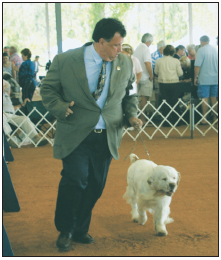
A champion in motion. Handler John Haenszel gaits Ch. Wild Cherry’s King of Hearts (“Albert”).
• Did you purchase a “show-quality” puppy from the breeder?
• Is your puppy at least six months of age?
• Does the puppy exhibit correct show type for his breed?
• Does your puppy have any disqualifying faults?
• Is your Clumber Spaniel registered with the American Kennel Club?
• How much time do you have to devote to training, grooming, conditioning and exhibiting your dog?
• Do you understand the rules and regulations of a dog show?
• Do you have time to learn how to show your dog properly?
• Do you have the financial resources to invest in showing your dog?
• Will you show the dog yourself or hire a professional handler?
• Do you have a vehicle that can accommodate your weekend trips to the dog shows?

It’s a family affair: Eileen Heiple with Crystal, Beau and Brit.
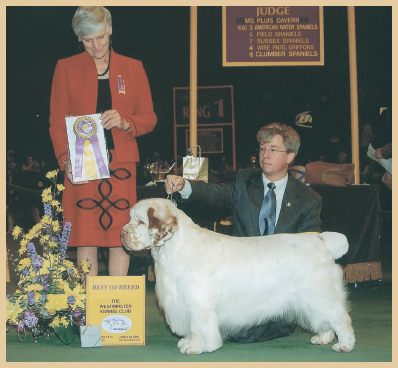
Ch. Vishnu Quijote Del Cipres, handled to the Breed win by Douglas Johnson at the 2005 Westminster show.
Success in the show ring requires more than a pretty face, a waggy tail and a pocketful of liver. Even though dog shows can be exciting and enjoyable, the sport of conformation makes great demands on the exhibitors and the dogs. Winning exhibitors live for their dogs, devoting time and money to their dogs’ presentation, conditioning and training. Very few novices, even those with good dogs, will find themselves in the winners’ circle, though it does happen. Don’t be disheartened, though. Every exhibitor began as a novice and worked his way up to the Group ring. It’s the “working your way up” part that you must keep in mind.
FOR MORE INFORMATION…
For reliable up-to-date information about registration, dog shows, parent clubs and other canine competitions for all breeds, contact one of the national registries by mail or via the Internet.
American Kennel Club
5580 Centerview Dr., Raleigh, NC 27606-3390
Canadian Kennel Club
89 Skyway Ave., Suite 100, Etobicoke,
Ontario M9W 6R4, Canada
The Kennel Club
1-5 Clarges St., Piccadilly,
London W1Y 8AB, UK
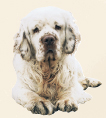
Assuming that you have purchased a puppy of the correct type and quality for showing, let’s begin to examine the world of showing and what’s required to get started. The entry fee into a dog show is usually around $25, but there are lots of other hidden costs involved with “finishing” your Clumber Spaniel, that is, making him a champion. Things like equipment, travel, training and conditioning all cost money. A more serious campaign will include fees for a professional handler, boarding, cross-country travel and advertising. Top-winning show dogs can represent a very considerable investment—over $100,000 has been spent in campaigning some dogs. (The investment can be less, of course, for owners who show their own dogs and don’t use professional handlers.)
Many owners, on the other hand, enter their “average” Clumber Spaniels in dog shows for the fun and enjoyment of it. Dog showing makes an absorbing hobby, with many rewards for dogs and owners alike. If you’re having fun, meeting other people who share your interests and enjoying the overall experience, you likely will catch the “bug.” Once the dog-show bug bites, its effects can last a lifetime; it’s certainly much better than a deer tick! Soon you will be envisioning yourself in the center ring at the Westminster Kennel Club Dog Show in New York City, competing for the prestigious Best in Show cup. This magical dog show is televised annually from Madison Square Garden, and the victorious dog becomes a celebrity overnight. Clumber fanciers were glued to their televisions and ecstatic when Ch. Clussexx Country Sunrise became the first of our breed to win Best in Show at Westminster.

Janice Friis showing Ch. Locksley Critter Tintagel (“Picabo”) to Best of Winners.
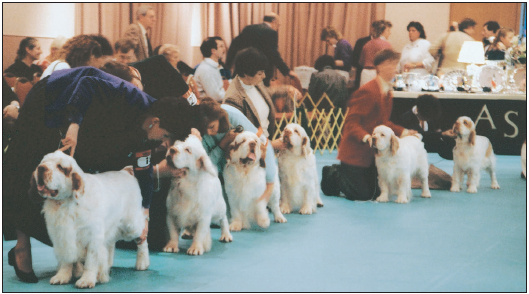
Clumbers in the breed ring, getting stacked and ready to look their best for the judge.
AKC CONFORMATION SHOWING
GETTING STARTED
Visiting a dog show as a spectator is a great place to start. Pick up the judging schedule and show catalog to find out what time your breed is being shown, who is judging the breed and in which ring the classes will be held. To start, Clumber Spaniels compete against other Clumber Spaniels, and the winner is selected as Best of Breed by the judge. This is the procedure for each breed. At a Group show, all of the Best of Breed winners go on to compete for Group One (first place) in their respective groups. For example, all Best of Breed winners in a given group compete against each other; this is done for all seven groups. Finally, all seven Group winners go head to head in the ring for the Best in Show award.
What most spectators don’t understand is the basic idea of conformation. A dog show is often referred as a “conformation” show. This means that the judge should decide how each dog stacks up (conforms) to the breed standard for his given breed: how well does this Clumber Spaniel conform to the ideal representative detailed in the standard? Ideally, this is what happens. In reality, however, this ideal often gets slighted as the judge compares Clumber Spaniel #1 to Clumber Spaniel #2. Again, the ideal is that each dog is judged based on his merits in comparison to his breed standard, not in comparison to the other dogs in the ring. It is easier for judges to compare dogs of the same breed to decide which they think is the better specimen; in the Group and Best in Show rings, however, it is very difficult to compare one breed to another, like apples to oranges. Thus the dog’s conformation to the breed standard—not to mention advertising dollars and good handling—is essential to success in conformation shows. The dog described in the standard (the standard for each AKC breed is written and approved by the breed’s national parent club and then submitted to the AKC for approval) is the perfect dog of that breed, and breeders keep their eye on the standard when they choose which dogs to breed, hoping to get closer and closer to the ideal with each litter.
SHOW POTENTIAL
How possible is it to predict how your ten-week-old puppy will eventually do in the show ring? Most show dogs take a few years to reach their prime, when their bodies are physically mature and their coats are in “full bloom.” Experienced breeders, having watched countless pups grow into Best of Breed winners, recognize the glowing attributes that spell “show potential.” When selecting a puppy for show, it’s best to trust the breeder to recommend which puppy will best suit your aspirations. Some breeders recommend starting with a male puppy, which likely will be more “typey” than his female counterpart.
Another good first step for the novice is to join a dog club. You will be astonished by the many and different kinds of dog clubs in the country, with about 5,000 clubs holding events every year. Most clubs require that prospective new members present two letters of recommendation from existing members. Perhaps you’ve made some friends visiting a show held by a particular club and you would like to join that club. Dog clubs may specialize in a single breed, or in a specific pursuit, such as obedience, tracking or hunting tests. There are all-breed clubs for all dog enthusiasts; they may sponsor special training days, seminars on topics like grooming or handling or lectures on breeding or canine genetics. There are also clubs that specialize in certain types of dogs, like herding dogs, hunting dogs, companion dogs, etc.
A parent club is the AKC-sanctioned national organization that promotes and safeguards its breed in the country. The Clumber Spaniel Club of America was formed in 1972 and can be contacted on the Internet at www.clumbers.org. The parent club holds an annual national specialty show, usually in a different part of the country each year, where most of the country’s top dogs, handlers, exhibitors and breeders gather to compete.
At these specialty shows, only members of a single breed participate. These special events often take place over the course of about a week and include many educational and social events, such as health seminars, extra competitions, breeder forums and parties. Attending a national specialty is the best way to see and appreciate the largest number of examples of a breed, especially in rarer breeds such as the Clumber Spaniel. It is the place to begin to and continue to learn about a breed’s history, health and conformation. For novices, attendance at these events can open up a new world of friendship and introduce them to the camaraderie of shared interest in their chosen breed.
MEET THE AKC
The American Kennel Club is the main governing body of the dog sport in the United States. Founded in 1884, the AKC consists of 500 or more independent dog clubs plus 4,500 affiliated clubs, all of which follow the AKC rules and regulations. Additionally, the AKC maintains a registry for pure-bred dogs in the US and works to preserve the integrity of the sport and its continuation in the country. Over 1,000,000 dogs are registered each year, representing about 150 recognized breeds. There are over 15,000 competitive events held annually for which over 2,000,000 dogs enter to participate. Dogs compete to earn over 40 different titles, from Champion to Companion Dog to Master Agility Champion.
HOW SHOWS ARE ORGANIZED
Three kinds of conformation shows are offered by the AKC. There is the all-breed show, in which all AKC-recognized breeds can compete; the specialty show, which is for one breed only and usually sponsored by the breed’s parent club and the Group show, for all breeds in one of the AKC’s seven groups. The Clumber Spaniel competes in the Sporting Group.
For a dog to become an AKC champion of record, the dog must earn 15 points at shows. The points must be awarded by at least three different judges and must include two “majors” under different judges. A “major” is a three-, four- or five-point win, and the number of points per win is determined by the number of dogs competing in the show on that day. (Dogs that are absent or are excused are not counted.) The number of points that are awarded varies from breed to breed. More dogs are needed to attain a major in more popular breeds, and fewer dogs are needed in less popular breeds. Yearly, the AKC evaluates the number of dogs in competition in each division (there are 14 divisions in all, based on geography) and may or may not change the numbers of dogs required for each number of points. The Clumber Spaniel attracts numerically proportionate representation at all-breed shows.
Only one dog and one bitch of each breed can win points at a given show. There are no “coed” classes except for champions of record. Dogs and bitches do not compete against each other until they are champions. Dogs that are not champions (referred to as “class dogs”) compete in one of six or seven classes. The class in which a dog is entered depends on age and previous show wins. First there is the Puppy Class (sometimes divided further into classes for 6- to 9-month-olds and 9- to 12- month-olds, and specialty shows sometimes have a 12- to 18- month-old class); next is the Novice Class (for dogs that have no points toward their championships and whose only first-place wins have come in the Puppy Class or the Novice Class, the latter class limited to three first places); then there is the American-bred Class (for dogs bred in the US); the Bred-by- Exhibitor Class (for dogs handled by their breeders or by immediate family members of their breeders) and the Open Class (for any non-champions). Any dog may enter the Open Class, regardless of age or win history, but to be competitive the dog should be older and have ring experience.

Each dog’s gait is evaluated by the judge. The Clumber should move with effortless drive in the breed’s characteristic rolling fashion.
The judge at the show begins judging the male dogs in the Puppy Class(es) and proceeds through the other classes. The judge awards first through fourth place in each class. The first-place winners of each class then compete with one another in the Winners Class to determine Winners Dog. The judge then starts over with the bitches, beginning with the Puppy Class(es) and proceeding up to the Winners Class to award Winners Bitch, just as he did with the dogs. A Reserve Winners Dog and Reserve Winners Bitch are also selected; they could be awarded the points in the case of a disqualification.
The Winners Dog and Winners Bitch are the two that are awarded the points for their breed. They then go on to compete with any champions of record (often called “specials”) of their breed that are entered in the show. The champions may be dogs or bitches; in this class, all are shown together. The judge reviews the Winners Dog and Winners Bitch along with all of the champions to select the Best of Breed winner. The Best of Winners is selected between the Winners Dog and Winners Bitch; if one of these two is selected Best of Breed as well, he or she is automatically determined Best of Winners. Lastly, the judge selects Best of Opposite Sex to the Best of Breed winner. The Best of Breed winner then goes on to the Group competition.
At a Group or all-breed show, the Best of Breed winners from each breed are divided into their respective groups to compete against one another for Group One through Group Four. Group One is awarded to the dog that best lives up to the ideal for his breed as described in the standard. A Group judge, therefore, must have a thorough working knowledge of many breed standards. After placements have been made in each group, the seven Group One winners (from the Sporting Group, Toy Group, Hound Group, etc.) compete against each other for the top honor, Best in Show.
There are different ways to find out about dog shows in your area. The American Kennel Club’s monthly magazine, the American Kennel Gazette is accompanied by the Events Calendar; this magazine is available through subscription. You can also look on the AKC’s and the Clumber Spaniel Club of America’s websites for information and check the event listings in your local newspaper.
Your Clumber Spaniel must be six months of age or older and registered with the AKC in order to be entered in AKC-sanctioned shows in which there are classes for the Clumber Spaniel. Your Clumber Spaniel also must not possess any disqualifying faults and must be sexually intact. The reason for the latter is simple: dog shows are the proving grounds to determine which dogs and bitches are worthy of being bred. If they cannot be bred, that defeats the purpose! On that note, only dogs that have achieved championships, thus proving their excellent quality, should be bred. If you have spayed or neutered your dog, however, there are many AKC events other than conformation, such as obedience trials, agility trials and the Canine Good Citizen® Program, in which you and your Clumber Spaniel can participate.

A first for the Clumber Spaniel in the US: this is Ch. Clussexx Country Sunrise, winning the most prestigious show in the US, the Westminster Kennel Club, in 1996. “Brady” was handled by Jane Alston-Myers, winning under judge D. Roy Holloway.
YOU’RE AT THE SHOW, NOW WHAT?
You will fill out an entry form when you register for the show. You must decide and designate on the form in which class you will enter your puppy or adult dog. Remember that some classes are more competitive than others and have limitations based on age and win history. Hopefully you will not be in the first class of the day, so you can take some time watching exactly how the judge is conducting the ring. Notice how the handlers are “stacking” their dogs, meaning setting them up. Does the judge prefer the dogs to be facing one direction or another? Take special note as to how the judge is moving the dogs and how he is instructing the handlers. Is he moving them up and back, once or twice around, in a triangle?
If possible, you will want to get your number beforehand. Your assigned number must be attached as an armband. Do not enter the ring without your number. The ring steward will usually call the exhibits in numerical order. If the exhibits are not called in order, you should strategically place your dog in the line. For instance, if your pup is small for his age, don’t stand him next to a large entry; if your dog is reluctant to gait, get at the end of the line-up so that you don’t interfere with the other dogs. The judge’s first direction, usually, is for all of the handlers to “take the dogs around,” which means that everyone gaits his dog around the periphery of the ring.
While you’re in the ring, don’t let yourself (or your dog) become distracted. Even when you think the judge is not looking at you and your dog, never let your dog stand in an awkward position. The judge could turn to look at you at any time. Concentrate on your dog; he should have your full attention. Stack him in the best way possible. Teach him to free-stand while you hold a treat out for him. Let him understand that he must hold this position for at least a minute before you reward him. Follow the judge’s instructions and be aware of what the judge is doing. Don’t frustrate the judge by not paying attention to his directions.
When your dog’s turn to be judged arrives, keep him steady and calm. The judge will inspect the dog’s bite and dentition, overall musculature and structure and, in a male dog, the testicles, which must completely descend into the scrotum. Likewise, the judge will take note of the dog’s alertness and temperament. Aggressiveness is a disqualification in most breeds, and so is shyness. A dog must always be approachable by the judge, even if aloofness is one of the breed’s characteristics. Once the judge has completed his hands-on inspection, he will instruct you to gait the dog. A dog’s gait indicates to the judge that the dog is correctly constructed. Each breed standard describes the ideal correct gait for that breed. After the judge has inspected all of the dogs in the class in this manner, he will ask the entire class to gait together. He will make his final selections after one last look over the class.
Whether you win or lose, the only one disappointed will be you. Never let your dog know that he’s not “the winner.” Most important is that you reaffirm your dog’s love of the game. Reward him for behaving properly and for being the handsome boy or pretty girl that he or she is.
After your first or second experience in the ring, you will know what things you need to work on. Go home, practice and have fun with your Clumber Spaniel. With some time and effort, you and your well-trained show dog will soon be standing in the winners’ circle with a blue ribbon!
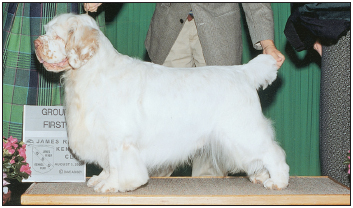
A win for Ch. Clussexx Billy Goats Gruff at the Roanoke Kennel Club show.
OTHER TYPES OF COMPETITION
In addition to conformation shows, the AKC holds a variety of other competitive events. Obedience trials, agility trials and tracking trials are open to all breeds, while hunting tests, field trials, lure coursing, herding tests and trials, earthdog tests and coonhound events are limited to specific breeds or groups of breeds. Junior Showmanship is offered to aspiring young handlers and their dogs, and the Canine Good Citizen® (CGC) Program is an all-around good-behavior test open to all dogs, pure-bred and mixed. The CGC is a highly recommended program for all dogs, as it encourages the kind of good social behavior that makes dogs more welcome in their neighborhoods and communities. It also underlines the importance of training to allow dogs to fit better into their families and to make the human-canine bond stronger.
OBEDIENCE TRIALS
Mrs. Helen Whitehouse Walker, a Standard Poodle fancier, can be credited with introducing obedience trials to the United States. In the 1930s she designed a series of exercises based on those of the Associated Sheep, Police, Army Dog Society of Great Britain. These exercises were intended to evaluate the working relationship between dog and owner. Since those early days of the sport in the US, obedience trials have grown more and more popular, and now more than 2,000 trials each year attract over 100,000 dogs and their owners. Any dog registered with the AKC, regardless of neutering or other disqualifications that would preclude entry in conformation competition, can participate in obedience trials.
There are three levels of difficulty in obedience competition. The first (and easiest) level is the Novice, in which dogs can earn the Companion Dog (CD) title. The intermediate level is the Open level, in which the Companion Dog Excellent (CDX) title is awarded. The advanced level is the Utility level, in which dogs compete for the Utility Dog (UD) title. Classes at each level are further divided into “A” and “B,” with “A” for beginners and “B” for those with more experience. In order to win a title at a given level, a dog must earn three “legs.” A “leg” is accomplished when a dog scores 170 or higher (200 is a perfect score). The scoring system gets a little trickier when you understand that a dog must score more than 50% of the points available for each exercise in order to actually earn the points. Available points for each exercise range between 20 and 40.
CANINE GOOD CITIZEN®
Have you ever considered getting your dog “certified”? The AKC’s Canine Good Citizen® Program affords your dog just that opportunity. Your dog shows that he is a well-behaved canine citizen, using the basic training and good manners you have taught him, by taking a series of ten tests that illustrate that he can behave properly at home, in a public place and around other dogs. The tests are administered by participating dog clubs, colleges, 4-H clubs, Scouts and other community groups and are open to all pure-bred and mixed-breed dogs. Upon passing the ten tests, the suffix CGC is then applied to your dog’s name.
The ten tests are: 1. Accepting a friendly stranger; 2. Sitting politely for petting; 3. Appearance and grooming; 4. Walking on a lead; 5. Walking through a group of people; 6. Sit, down and stay on command; 7. Coming when called; 8. Meeting another dog; 9. Calm reaction to distractions; 10. Separation from owner.
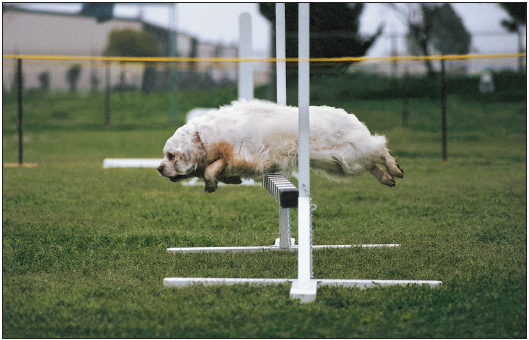
This marvelously trained Clumber Spaniel is clearing the bar jump at an obedience trial.
A dog must complete different exercises at each level of obedience. The Novice exercises are the easiest, with the Open and finally the Utility levels progressing in difficulty. Examples of Novice exercises are on- and off-lead heeling, a figure-8 pattern, performing a recall (or come), long sit and long down and standing for examination. In the Open level, the Novice-level exercises are required again, but this time without a leash and for longer durations. In addition, the dog must clear a broad jump, retrieve over a jump and drop on recall. In the Utility level, the exercises are quite difficult, including executing basic commands based on hand signals, following a complex heeling pattern, locating articles based on scent discrimination and completing jumps at the handler’s direction.
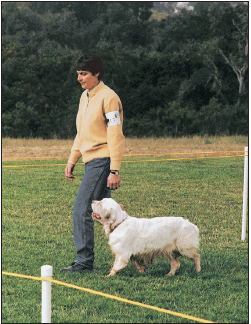
To compete in obedience trials, the Clumber Spaniel must be able to follow the handler’s commands without fail. Note how attentive this Clumber is to his master’s next move.
Once he’s earned the UD title, a dog can go on to win the prestigious title of Utility Dog Excellent (UDX) by winning “legs” in ten shows. Additionally, Utility Dogs who win “legs” in Open B and Utility B earn points toward the lofty title of Obedience Trial Champion (OTCh.). Established in 1977 by the AKC, this title requires a dog to earn 100 points as well as three first places in a combination of Open B and Utility B classes under three different judges. The “brass ring” of obedience competition is the AKC’s National Obedience Invitational. This is an exclusive competition for only the cream of the obedience crop. In order to qualify for the invitational, a dog must be ranked in either the top 25 all-breeds in obedience or in the top three for his breed in obedience. The title at stake here is that of National Obedience Champion (NOC).
AGILITY TRIALS
Agility trials became sanctioned by the AKC in August 1994, when the first licensed agility trials were held. Since that time, agility certainly has grown in popularity by leaps and bounds, literally! The AKC allows all registered breeds (including Miscellaneous Class breeds) to participate, providing the dog is 12 months of age or older. Agility is designed so that the handler demonstrates how well the dog can work at his side. The handler directs his dog through, over, under and around an obstacle course that includes jumps, tires, the dog walk, weave poles, pipe tunnels, collapsed tunnels and more. While working his way through the course, the dog must keep one eye and ear on the handler and the rest of his body on the course. The handler runs along with the dog, giving verbal and hand signals to guide the dog through the course.
The first organization to promote agility trials in the US was the United States Dog Agility Association, Inc. (USDAA). Established in 1986, the USDAA sparked the formation of many member clubs around the country. To participate in USDAA trials, dogs must be at least 18 months of age.
The USDAA and AKC both offer titles to winning dogs, although the exercises and requirements of the two organizations differ. Agility Dog (AD), Advanced Agility Dog (AAD) and Master Agility Dog (MAD) are the titles offered by the USDAA, while the AKC offers Novice Agility (NA), Open Agility (OA), Agility Excellent (AX) and Master Agility Excellent (MX). Beyond these four AKC titles, dogs can win additional titles in “jumper” classes: Jumper with Weave Novice (NAJ), Open (OAJ) and Excellent (MXJ). The ultimate title in AKC agility is MACH, Master Agility Champion. Dogs can continue to add number designations to the MACH title, indicating how many times the dog has met the title’s requirements (MACH1, MACH2 and so on).
Agility trials are a great way to keep your dog active, and they will keep you running, too! You should join a local agility club to learn more about the sport. These clubs offer sessions in which you can introduce your dog to the various obstacles as well as training classes to prepare him for competition. In no time, your dog will be climbing A-frames, crossing the dog walk and flying over hurdles, all with you right beside him. Your heart will leap every time your dog jumps through the hoop—and you’ll be having just as much (if not more) fun!
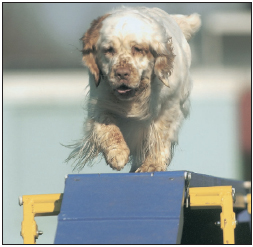
Across the dog walk…
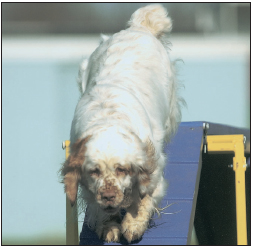
On the way down…
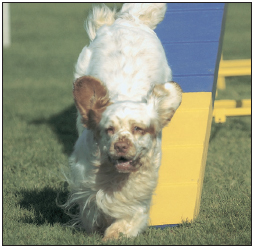
And off and running, on to conquer the next obstacle!
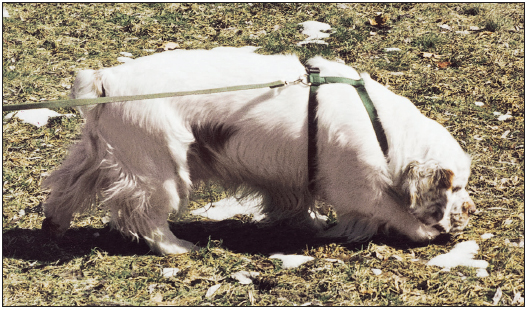
Here’s Am./Can. Ch. Critter’s Hungry Heart TD, CD, JH, CGC, showing off his remarkable nose. Clumbers make fine tracking dogs and prove to be consistent, persistent performers.
TRACKING
Tracking tests are exciting ways to test your Clumber Spaniel’s instinctive scenting ability on a competitive level. All dogs have a nose, and all breeds are welcome in tracking tests. Clumbers enjoy working for tracking titles and are quite good at it. The first AKC-licensed tracking test took place in 1937 as part of the Utility level at an obedience trial, and thus competitive tracking was officially begun. The first title, Tracking Dog (TD), was offered in 1947, ten years after the first official tracking test. It was not until 1980 that the AKC added the title Tracking Dog Excellent (TDX), which was followed by the title Variable Surface Tracking (VST) in 1995. Champion Tracker (CT) is awarded to a dog who has earned all three of those titles.
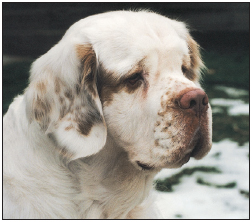
Am./Can. Ch. Raycroft Springsteen TD is a handsome and accomplished Clumber from the Great Lakes region of the country. The suffix TD is an American Kennel Club title for Tracking Dog.
The TD level is the first and most basic level in tracking, progressing in difficulty to the TDX and then the VST. A dog must follow a track laid by a human 30 to 120 minutes prior in order to earn the TD title. The track is about 500 yards long and contains up to 5 directional changes. At the next level, the TDX, the dog must follow a 3- to 5-hour-old track over a course that is up to 1,000 yards long and has up to 7 directional changes. In the most difficult level, the VST, the track is up to 5 hours old and located in an urban setting.
HUNTING TESTS
Hunting tests are not competitive like field trials, and participating dogs are judged against a standard, as in a conformation show. Clumber Spaniels are eligible to participate in hunting tests, and they particularly enjoy the work that they were bred to do. At this time there are 48 Clumber Spaniels who have earned hunting titles. The first hunting tests were devised by the North American Hunting Retriever Association (NAHRA) as an alternative to field trials for retriever owners to appreciate their dogs’ natural innate ability in the field without the expense and pressure of a formal field trial. The intent of hunting tests is the same as that of field trials: to test the dog’s ability in a simulated hunting scenario.
The AKC instituted its hunting tests in June 1985; since then, their popularity has grown tremendously. The AKC offers three titles at hunting tests, Junior Hunter (JH), Senior Hunter (SH) and Master Hunter (MH). Each title requires that the dog earn qualifying “legs” at the tests: the JH requiring four; the SH, five; and the MH, six.
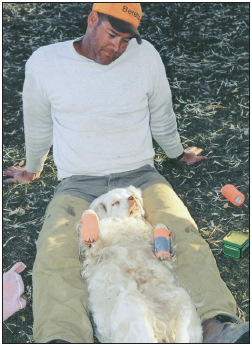
Bob Wickwire and Maddie relax and get cleaned up after a day on the hunt.
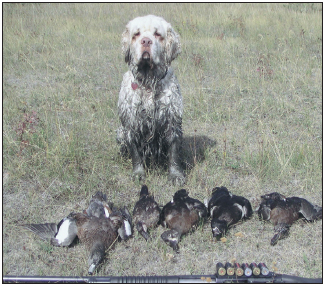
Am./Can. Ch. Flyaway Corey’s John Glenn CGC, WDX, MH, known as “Herschel,” is an active hunter with his owner and in competition. Just a week after winning a gundog specialty, he poses with the fruits of his day’s labor in the field.